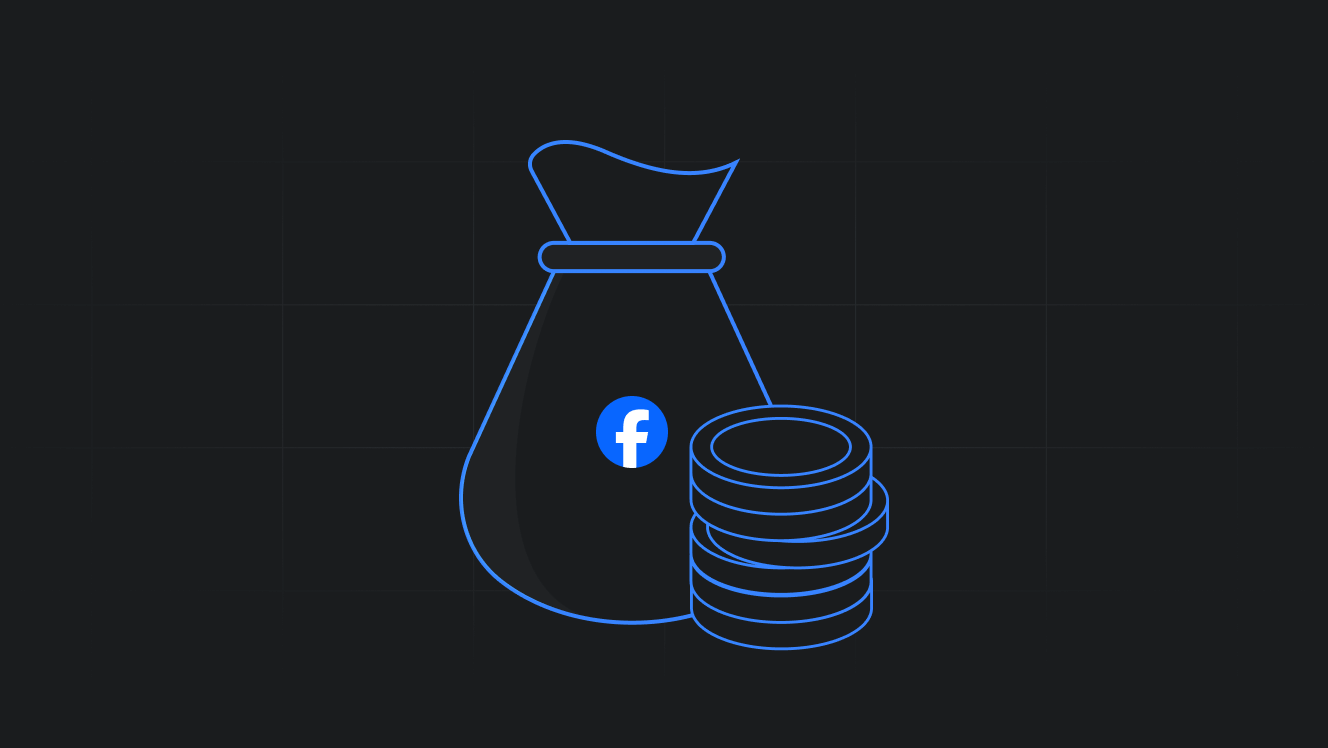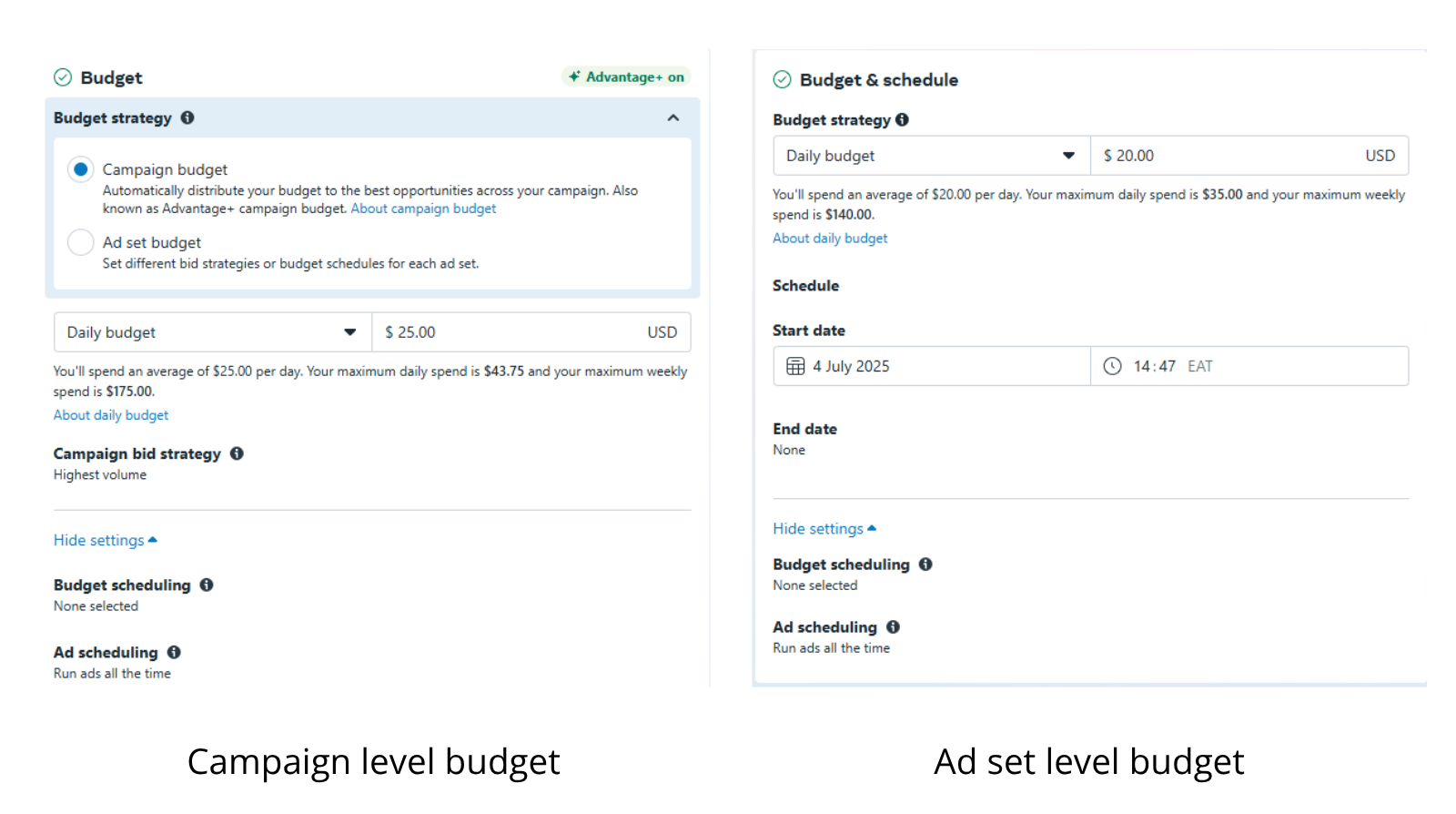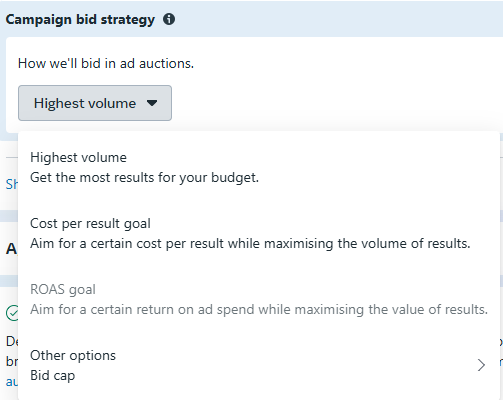Facebook Ad Budget: How Much to Spend + Benchmarks & Optimization Tips
Find out everything you need to know about budgeting options in Meta Ads Manager, performance benchmarks, testing strategies, and how to get better results even with a small budget.



If you’re thinking, ‘I’m new to this whole Facebook advertising thing, how much do I even allocate as my ad budget?’ We’ve got you.
The shortest answer is, it depends.
Yes, that’s the most frustrating answer, but your Facebook ad budget really does depend on your industry, goals, product price, and even the location of your target audience.
That said, there are several strategies you can use to determine your Facebook ad budget, as you’ll learn today.
In this guide, we’ll break down:
- How to set or allocate your budget in Meta Ads Manager
- Benchmarks to keep in mind
- Testing strategies to help you find what works for your brand
- How to make your budget stretch further if you're starting small
But first things first, let’s show you where to find budget settings inside Meta Ads Manager.
Key takeaways
- You don’t need a massive budget to start running Facebook ads, but you do need to give Meta enough room to learn. Even $5/day can work if you’re patient and strategic.
- Facebook’s algorithm performs best when you aim for 50 conversions per week per ad set, but if you fall short, you can still get results, but with a longer learning curve.
- Advertisers sabotage performance when they test too many variables at once. Focus instead on one product per campaign to give Meta the data it needs to optimize effectively.
How to set or allocate a budget in Meta Ads Manager
Facebook ad budget allocation happens when you're creating a campaign inside Meta Ads Manager. You have two options for where to set your budget:
- At the campaign level, also known as the Advantage+ campaign budget or Campaign Budget Optimization(CBO)
- At the ad set level
What’s the difference?
When you use a campaign-level budget, you set one overall budget for the campaign, and Meta automatically distributes it across your ad sets based on performance.
If one ad set is doing better, Meta will allocate more money there to get you better results overall.
This is a great option when:
- Your ad sets are similar
- You want Meta to optimize spending across them
- You don’t need strict control over each ad set’s budget
If you set your budget at the ad set level, you decide exactly how much money goes to each ad set.
This control is useful when you’re testing different audiences, placements, or offers and want to manage spending individually.
Either way, both options let you choose:
- A daily or lifetime budget
- Budget scheduling (set start and end dates)
- Ad scheduling (choose specific hours or days to run ads if you're using a lifetime budget)

Campaign bid strategy: How Meta decides where to spend your budget
If you choose to use the Advantage+ campaign budget (CBO), there’s one more setting you need to understand: your campaign bid strategy.
A bid strategy tells Meta how to spend your budget in the ad auction. Meta gives you only #4 bid strategies:

Highest volume (formerly lowest cost)
Meta’s default and most flexible strategy. It tries to get you as many results as possible for your budget without worrying about how much each individual result costs.
It’s an excellent choice when you want to scale quickly and don’t have strict CPA or ROAS goals.
Use it when:
- You're optimizing for conversions, traffic, or engagement
- You care more about volume than consistency in cost
- You're testing new audiences or creatives
Cost per result
With this strategy, you set a target cost per conversion, for example, $10 per purchase, and Meta tries to stick to that average. It gives you more control than the highest volume bid but still lets the system adapt based on performance.
Use it when:
- You want predictable CPAs
- You have clear cost targets in mind
- You're past the testing phase and are now focused on efficiency
Pro tip from Meta: Your daily budget should be at least 5x your cost per result goal. So, if your goal is $5 per result, aim for at least $25 per day.
ROAS goal
In this case, you tell Meta how much return you want for every dollar spent. For example, if you spend $1 and want $5 in return, you set a 5x ROAS goal. Meta then bids for conversions likely to generate that return.
Use it when:
- Your campaign is optimized for purchases
- You’re tracking revenue through the pixel or Conversions API
Bid cap
For this bidding strategy, you set the maximum you're willing to bid in the auction. Meta won’t go above it, which can protect your margins, but it may limit delivery if bids are too low.
Use it when:
- You know your numbers and need tight cost control
- You can afford to trade off reach for precision
Daily vs. lifetime budget
Both campaign-level and ad set-level budgets give you the option to choose between a daily or lifetime budget.
When you set a daily budget, you're telling Meta how much you're willing to spend on average per day.
However, on high-performing days, Meta may spend up to 75% more than your set daily budget to take advantage of better results.
For instance, if your daily budget is $100, Meta might spend up to $175 on a good day. However, your total spend won’t exceed 7x your daily budget over a week (Sunday to Saturday). In this case, your weekly ad spend won’t exceed $700.
With a lifetime budget, you're telling Meta the total amount you're willing to spend across the full duration of your campaign or ad set.
Meta then spreads that amount over time. The algorithm will spend more on days when it sees better performance potential and less when the chances of good results are lower.
This works best if you're flexible about daily spending but want to cap your total investment.
How much should you spend on Facebook Ads?
There’s no one answer to this, but the best place to start is with YOUR numbers. More specifically, your product price, your break-even ROAS, and your risk tolerance.
1. Start with a budget you can afford to lose
Your starting Facebook ad budget should be an amount that won’t hurt your business if things don’t work right away but also not so small that it doesn’t do anything for your campaign.
A helpful way to think about it is this: Spend what gives Meta enough room to learn and optimize without putting your business at financial risk.
2. Use your break-even ROAS to set your baseline
This is one of the traditional ways to determine how much to spend on ads, but it’s not always the most affordable, as you’ll see in a few minutes.
For example, if you run an eCommerce store, and your average order value (AOV) is $50, you’ll need to make $2 in revenue for every $1 spent to break even.
Your maximum cost per purchase should, therefore, be $25.
Now, if we consider that Meta recommends aiming for around 50 conversions per week per ad set to get out of the learning phase, here’s how that math looks:
- 50 conversions × $25 = $1,250/week
- That’s around $5,000/month
- Or about $179/day
Of course, you should lower your cost per conversion over time, but this method gives you a realistic starting point to work with.
However, if you are a small business or new to Meta ads, $179/day is quite a lot.
If that’s your situation, you can still work with a lower budget than $179/day.
However, you’ll be forced to adjust your expectations. With less data coming in, the learning phase will take longer, and results might be more unpredictable.
To make a smaller budget work:
- Narrow your targeting so fewer conversions are needed to optimize
- Run fewer ad sets (ideally just one or two if you’re spending $50/day or less)
- Be patient
3. Consider your product, industry, and target region
Your budget will also vary depending on:
- The price of your product (lower-priced products need cheaper CPCs to stay profitable)
- Your industry benchmarks (e.g., average ROAS for eCommerce is 2.05)
- The region you’re targeting (ads in Tier 1 countries usually cost more than ads in emerging markets)
Knowing these factors helps you benchmark what’s normal in your space and how much you’ll need to spend to be competitive.
Budget-based Facebook ad metrics to monitor
When you have your ads up and running, pay attention to these #3 metrics:
Return on ad spend (ROAS)
ROAS measures how much revenue you earn for every dollar spent on ads. A good ROAS is one that beats your break-even point and ideally gets close to or above your industry average.
For example:
- The average ROAS for eCommerce is around 2.05
- In more competitive sectors like cybersecurity, it’s closer to 1.40
In some cases, Facebook ads still work at lower ROAS levels, especially if your strategy includes retargeting or upsells. However, in general, you want to see a positive return.
You can explore more about what makes a good ROAS here.
Cost per thousand impressions (CPM)
CPM tells you how much you pay to get your ad seen 1,000 times. It’s a good indicator of how competitive your audience or placement is. According to the latest June 2025 data, the average Facebook CPM is around $14.69.
A high CPM might mean your targeting is too broad or your ad creative isn’t resonating with your target audience. You’ll need to test new angles or improve ad relevance to bring this down.
Cost per Click (CPC)
CPC shows how much you’re paying for each click on your ad. The lower it is, the more efficient your ad spend.
In June 2025, Birch data reported the average CPC at $0.729. Use this as a benchmark, but remember your actual CPC will depend on your niche, audience, and creative quality.
Optimizing your Facebook Ad budget
When working with a limited budget, which most small businesses are, every dollar counts. Below are a couple of strategies to make your budget go further and set your campaigns up for long-term success.
1. Stop chasing unrealistic ROAS goals
One of the biggest mistakes new advertisers make is expecting massive profits right away. Everyone wants a 10X ROAS from day one, but that’s not realistic when you're working with a small budget and a fresh ad account.
In the early stages, your focus shouldn’t be on making a huge profit. It should be on gathering conversion data, testing creatives, and giving Meta’s algorithm something to work with.
Be willing to spend more to acquire customers, even if it means breaking even or earning a lower ROAS, like 2X or 3X. Of course, this ROAS is less exciting, but it sets you up to scale. Once your campaigns start converting consistently:
- You get more optimization data
- You unlock better delivery from Meta
- You build a larger customer base for retargeting, referrals, and repeat business
2. Test strategically and give Meta time to learn
Before you think about scaling, you need to know what works for your specific products and account. That means a/b testing creatives, audiences, placements, and formats, but one variable at a time. When you change everything all at once, you can’t tell what’s causing the good results.
Start by testing just one product. If you try to test five or six products at the same time, Meta won’t know where to allocate the budget, and your campaigns will struggle to exit the learning phase. You’ll end up with scattered data, and none of the products will get enough traction to optimize properly. Keep it simple, focus on one product and campaign, and let Meta learn effectively.

Facebook Ads expert at Heath Media
3. Use retargeting
Retargeting is usually cheaper than prospecting. In fact, retargeted users can be up to 8x cheaper to reach per click.
When your campaigns start generating consistent traffic or sales, create custom audiences to retarget people who viewed products, added to cart, or engaged with your brand.
You’ll start seeing better ROAS with lower spend, since you’re targeting people already familiar with your offer.
4. Use high-quality creatives
Meta rewards relevance. The more engaging and tailored your ad is to your audience, the lower your CPM and CPC. According to Meta’s own guidance, ad quality directly affects how much you pay to reach people.
If you’re unsure what’s working in your niche, check the Facebook Ads Library or use Facebook ads spy tools to see how your competitors run their campaigns.
If an ad has been running for months, it’s probably performing well and can be a useful reference point for your own creative approach.
In eCommerce, you’re often expected to create dozens (sometimes hundreds) of product ad variations. It’s a big ask, and it's why so many Facebook catalog ads end up looking flat, repetitive, or forgettable.
Instead of burning hours on manual asset creation or settling for generic templates, you can use a catalog ad creation platform such as Cropink to automate the generation of high-performing product creatives.
These creatives are built around real-time data and customer behavior, which helps your ads stay relevant, engaging, and more likely to convert.
Case in point: When one of Cropink’s clients switched to enriched dynamic product ads, they saw:
- 3× higher conversion rate
- 9× higher ROAS
- 4× higher average order value
Better creatives will almost always result in better ROI from your budget.
Try it out! Cropink is free for your first 25 products.
What to do when your Facebook ad budget isn’t performing
- Check for ad fatigue. If your frequency is high(2x or more) and results are dropping, your audience has likely seen the same ad too many times. This is common when you run the same creative without rotation. To counteract ad fatigue, refresh your ads with new copy and creatives, or have a couple of ads on rotation.
- Narrow down your targeting. Broad audiences might look efficient on paper, but if they’re not converting, you’re paying for reach instead of results. Tighten your targeting to high-intent groups like people who viewed a product, added to cart, or engaged with your page in the last 30 days. Retargeting these warm audiences is usually cheaper anyway.
- Are you editing your ads too often? Changing your budget, creative, and targeting resets the learning phase. Unless your results are nose-diving, give your ads at least 48 to 72 hours before making changes. Meta needs consistent data to optimize delivery.
FAQs
There’s no fixed, recommended amount for Facebook ads. Your budget will depend on your goals, product price, and how competitive your industry is.
Yes, $5 a day can work for Facebook ads when starting out or testing. However, smaller budgets mean slower learning phases and potentially higher costs per result, so you'll need patience and focused targeting to see meaningful results. That said, at least $10 is a more realistic budget.
Facebook ads use an auction system, so costs vary by industry and competition. As of June 2025, average costs are $14.69 CPM and $0.729 CPC, but your actual costs depend on your targeting, ad quality, and bidding strategy.
While you can start with $5-10 per day, most businesses see better results with $50-100+ daily budgets. Higher budgets help campaigns exit the learning phase faster and provide more optimization data for Meta's algorithm to improve conversions.
Final thoughts
Facebook ads remain one of the most strategic and effective ways eCommerce companies can scale quickly and consistently. You can repeat your proven processes and ad structures to generate results and scale systematically.
Success ultimately comes down to implementing the strategies we've discussed above, but more importantly, learning your industry inside out and testing what works best for your specific business. Focus on gathering data first, then optimizing for profit as your campaigns mature.
If you're ready to pair your Facebook ad budget with on-brand, high-performing creatives, Cropink makes it easy to create and launch product ads without starting from scratch each time.
Contact us for a free demo today.
Sources
- First Page Sage. ROAS Statistics
- Birch. Facebook Advertising Costs by CPM
- Birch. Average CPC for Facebook Ads
- Ben Heath. How To Crush Facebook Ads with a Small Budget
- Facebook. Ad quality: What you should know

Damaris is a Digital Marketing Specialist who writes about digital marketing and performance marketing. At Cropink, she creates data-driven content to help businesses run better ad campaigns for better performance and ROI.

Leszek is the Digital Growth Manager at Feedink & Cropink, specializing in organic growth for eCommerce and SaaS companies. His background includes roles at Poland's largest accommodation portal and FT1000 companies, with his work featured in Forbes, Inc., Business Insider, Fast Company, Entrepreneur, BBC, and TechRepublic.
Related Articles
A lot of Facebook ad templates look polished, but can’t keep up when you need to create ads at scale. They don't connect to product feeds, support dynamic content, or handle the constant updates ecommerce brands need. Get 5 free templates that work with your catalog data and adapt automatically as your inventory changes.

Cyber Monday has changed from a desktop-first sales day to a mobile-first extension of Black Friday weekend. We’ll show you how to adjust your Meta Catalog Ads strategy for Cyber Monday shoppers who are more deliberate, comparison-focused, and ready to buy online.

Black Friday is the most competitive shopping event of the year, and your ad creatives will determine how much you sell. Find out how to create Meta Catalog Ads that attract shoppers and encourage them to convert without hesitation.

Learn the Meta ads targeting options that truly work in 2026. Broad targeting paired with first-party signals cuts CPA by 32%. 65% of advertisers now scale profitably using Advantage+ campaigns. Includes playbooks, pitfalls, and setup checklists.

Meta Pixel may seem technical, but it’s simpler than it looks. We explain what the Meta Pixel code is, how to install it, and how to troubleshoot common errors. You’ll also see a meta pixel code example and learn how to use Pixel data for retargeting, audience building, and measuring ad performance.

Facebook brand awareness campaigns fail when treated as standalone ads, but they're useful for filling your retargeting pipeline. This guide reveals expert strategies for targeting the right audiences and avoiding the budget-draining mistakes that kill most awareness campaigns before they deliver results.

Facebook has 3.06B users, ranks as the 3rd most-visited site in 2026, and drove $164.5B in ad revenue last year. Learn how to master its 19 ad placements—from high-engagement Reels to low-CPC right column ads—for maximum ROI.

With 3 billion+ users and detailed targeting, Facebook is still a powerful B2B channel. This guide breaks down winning ad formats, funnel tactics, and real-world results, including a 492% CTR lift, and why Facebook may outperform LinkedIn for many B2B brands.

Facebook reaches 2.91B users worldwide—learn how Instant Forms, Automated Chat, and smart targeting help you capture quality leads and cut costs without leaving the platform.

Meta Business Manager can certainly be overwhelming at first, but it doesn’t have to stay that way. This 4-step guide shows you how to set it up, add your assets, and keep everything secure so you can manage Facebook and Instagram marketing with ease.

Discover 11 tested ways to customize your Facebook Dynamic Product Ads for better performance. Learn how you can create DPAs that draw attention and increase conversions effortlessly.

Learning the difference between internal labels and custom labels can drastically change how your Meta catalog campaigns perform. This guide covers what makes them different and which one you should be using.

How Can Cropink Help?
Start with Cropink is easy and free
No credit card required